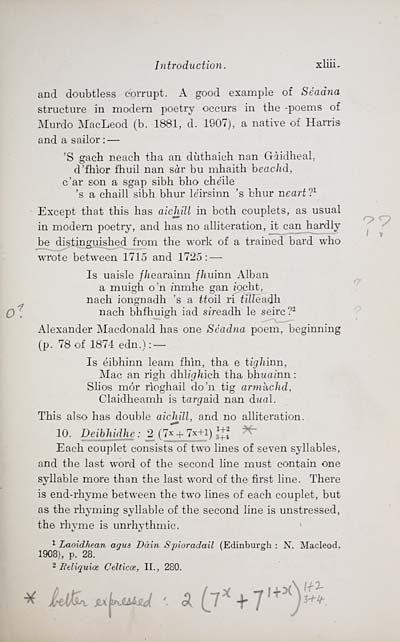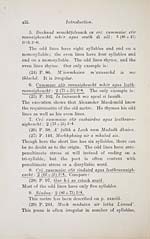Download files
Complete book:
Individual page:
Thumbnail gallery: Grid view | List view

Introduction. xliii.
and doubtless corrupt. A good example of Sèadna
structure in modem poetry occurs in the -poems of
Murdo MacLeod (b. 1881, d. 1907), a native of Harris
and a sailor : —
'S gach neach tha an dùthaich nan Gàidheal,
d'fhìor fhuil nan sàr bu mhaith heachd,
c'ar son a sgap sibh bho che'ile
's a chaill sibh bhur leirsinn 's bhur neart?^
■ Except that this has aichill in both couplets, as usual
in modem poetry, and has no alhteration, it can hardly
be distinguished from the work of a trained bard who
wrote between 1715 and 1725: —
Is uaisle //learainn fhuìnn Alban
a muigh o'n mmhe gan iocht,
nach iongnadh 's a ttoil ri tilleadh.
nach bhfhuigh iad sjreadh le seirc?^
Alexander Macdonald has one Sèadna poem, beginning
(p. 78 of 1874 edn.): —
Is èibhinn leam fhìn, tha e tighìnn,
Mac an righ dhìighieh tha hhuainn :
SUo'S mòr rloghail do'n tig armachd,
Claidheamh is tar^aid nan di<al.
This also has double aichill, and no alliteration.
10. Deibhidhe : 2 (7x+7x+i) 1^ ^
Each couplet consists of two hnes of seven syllables,
and the last word of the second line must contain one
syllable more than the last word of the first hne. There
is end-rhyme between the two hnes of each couplet, but
as the rhyming syllable of the second line is uustressed,
the rhyme is unrhythmic.
^ Laoidhean agus Dàin Spioradail (Edinburgh : N. Macleod,
1908), p. 28.
^ Reliquice Celticoe, II., 280.
)i ; O
and doubtless corrupt. A good example of Sèadna
structure in modem poetry occurs in the -poems of
Murdo MacLeod (b. 1881, d. 1907), a native of Harris
and a sailor : —
'S gach neach tha an dùthaich nan Gàidheal,
d'fhìor fhuil nan sàr bu mhaith heachd,
c'ar son a sgap sibh bho che'ile
's a chaill sibh bhur leirsinn 's bhur neart?^
■ Except that this has aichill in both couplets, as usual
in modem poetry, and has no alhteration, it can hardly
be distinguished from the work of a trained bard who
wrote between 1715 and 1725: —
Is uaisle //learainn fhuìnn Alban
a muigh o'n mmhe gan iocht,
nach iongnadh 's a ttoil ri tilleadh.
nach bhfhuigh iad sjreadh le seirc?^
Alexander Macdonald has one Sèadna poem, beginning
(p. 78 of 1874 edn.): —
Is èibhinn leam fhìn, tha e tighìnn,
Mac an righ dhìighieh tha hhuainn :
SUo'S mòr rloghail do'n tig armachd,
Claidheamh is tar^aid nan di<al.
This also has double aichill, and no alliteration.
10. Deibhidhe : 2 (7x+7x+i) 1^ ^
Each couplet consists of two hnes of seven syllables,
and the last word of the second line must contain one
syllable more than the last word of the first hne. There
is end-rhyme between the two hnes of each couplet, but
as the rhyming syllable of the second line is uustressed,
the rhyme is unrhythmic.
^ Laoidhean agus Dàin Spioradail (Edinburgh : N. Macleod,
1908), p. 28.
^ Reliquice Celticoe, II., 280.
)i ; O
Set display mode to: Large image | Transcription
Images and transcriptions on this page, including medium image downloads, may be used under the Creative Commons Attribution 4.0 International Licence unless otherwise stated. ![]()
| Early Gaelic Book Collections > Matheson Collection > Bardachd Ghaidhlig > (47) |
|---|
| Permanent URL | https://digital.nls.uk/76423078 |
|---|
| Description | Specimens of Gaelic poetry 1550-1900. |
|---|---|
| Shelfmark | Mat.50 |
| Additional NLS resources: | |
| Attribution and copyright: |
|
| Description | Items from a collection of 170 volumes relating to Gaelic matters. Mainly philological works in the Celtic and some non-Celtic languages. Some books extensively annotated by Angus Matheson, the first Professor of Celtic at Glasgow University. |
|---|
| Description | Selected items from five 'Special and Named Printed Collections'. Includes books in Gaelic and other Celtic languages, works about the Gaels, their languages, literature, culture and history. |
|---|

